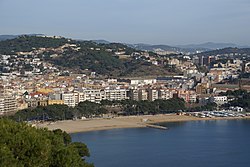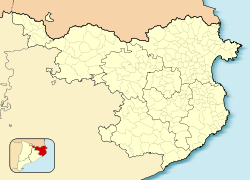Sant Feliu de Guixols
| Sant Feliu de Guíxols | |||
|---|---|---|---|
| Municipality | |||
 |
|||
|
|||
| Location in Catalonia | |||
| Coordinates: 41°47′N 3°02′E / 41.783°N 3.033°ECoordinates: 41°47′N 3°02′E / 41.783°N 3.033°E | |||
| Country |
|
||
| Community |
|
||
| Province | Girona | ||
| Comarca | Baix Empordà | ||
| Government | |||
| • Mayor | Carles Motas López (2015) | ||
| Area | |||
| • Total | 16.2 km2 (6.3 sq mi) | ||
| Elevation | 4 m (13 ft) | ||
| Population (2014) | |||
| • Total | 21,810 | ||
| • Density | 1,300/km2 (3,500/sq mi) | ||
| Demonym(s) | guixolenc, guixolense, feliuense,"ganxó" | ||
| Website | guixols |
||
Sant Feliu de Guíxols (Catalan pronunciation: [ˈsam fəˈɫiw ðə ˈɣiʃuɫs]) is a municipality in the comarca of the Baix Empordà in Catalonia, Spain. It is situated on the Costa Brava and is an important port and tourist centre. The district abuts to the north, the upmarket s'Agaró resort built round the Sant Pol Beach. In addition to tourism and the port the cork industry is a traditionally local industry. The town contains a large monastery which now houses the town museum and is a protected historico-artistic monument. The C-253 road runs north along the coast to Platja d'Aro and Palamós, while the C-65 road runs inland from the town. The GI-682 provides a dramatic cliff top drive to Tossa de Mar to the south.
Located on the Mediterranean, Sant Feliu de Guíxols has idylic weather almost all year long. The coastline of Sant Feliu de Guíxols spreads over ten kilometres (6.2 miles). It also includes many little bays with coves surrounded by pines with rocky or fine sand beaches. The beaches are cleaned daily and a modern water treatment system prevents wastewater from entering the sea. The town is engulfed by small mountains, with forests of pine, oak, and cork trees.
The name Sant Feliu goes back to the martyred saint, Feliu, who came from Africa. Guíxols is a word derived from the former word Iecsalis, of a document the 10th century that mentions to the monastery and that seems to mean "Rope-maker"
The Original Nucleus of the Town A township started to grow up on the basis of the various activities surrounding the Monestir de Sant Feliu de Guíxols. The settlement grew, and soon dwellings started to spring up on the other side of the watercourse, which would become the nucleus of the medieval town, centered on the market.
...
Wikipedia




